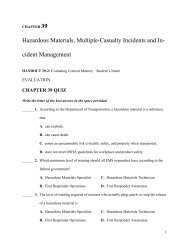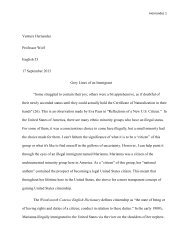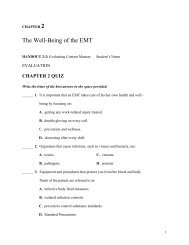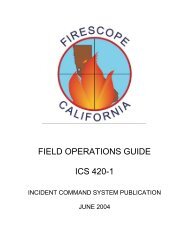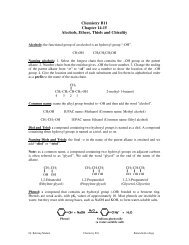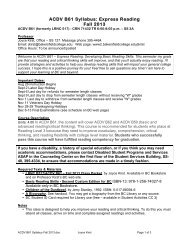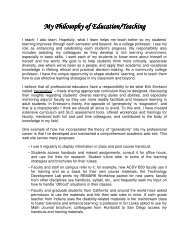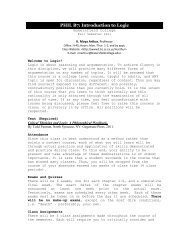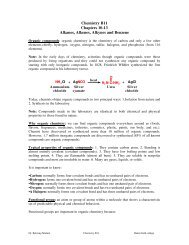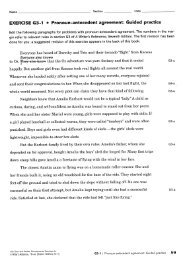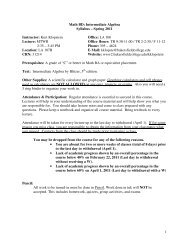Syllabus Chemistry B1B Fall 2012 - Bakersfield College
Syllabus Chemistry B1B Fall 2012 - Bakersfield College
Syllabus Chemistry B1B Fall 2012 - Bakersfield College
You also want an ePaper? Increase the reach of your titles
YUMPU automatically turns print PDFs into web optimized ePapers that Google loves.
<strong>Syllabus</strong><strong>Chemistry</strong> <strong>B1B</strong><strong>Fall</strong> <strong>2012</strong>“One important key to success is self-confidence. An important key to selfconfidenceis preparation.”- Arthur Ashe“ A mans got to know his limitations!” - Dirty Hairy
CHEM <strong>B1B</strong>: GENERAL CHEMISTRY and CHEMICAL ANALYSISSpring <strong>2012</strong>CRN 70947 (Chem <strong>B1B</strong>) MW 9:35 - 11:00 am SE 18 LectureCRN 70947 (Chem <strong>B1B</strong>) MW 1:00 – 4:10 pm SE 26 LaboratoryCRN 70945 (Chem B1A) TR 1:00 – 4:10 pm SE 27 LaboratoryInstructor: Dr. Wayne CooperOffice:SE-18Office Phone: 395-4671Email:wcooper@bakersfieldcollege.eduWeb site: http://www2/bakersfieldcollege.edu/wcooperOffice Hours: On my web site, posted by my office, or by appointmentCourse Prerequisites: <strong>Chemistry</strong> B1A with a grade of C or betterTextbook: Jespersen, Brady and Hyslop, "<strong>Chemistry</strong>, The Molecular Nature of Matter", 6 th EdOptional: Any study guide you find useful (check it out before you buy).Other Supplies:1) iClicker (Purchase from bookstore) Bring your iClicker to every class.2) Scientific Calculator: (TI–30 series, Solar powered are best). Bring your calculator to every classand lab. No programmable calculators allowed for use on exams.3) Lab coat or apron covering the chest and down to the knees, UVEX goggles and a combinationlock. The goggles must completely enclose the area around the eyes. (Z87 standard)4) USERID to use BC's personal computer labs. Even if you already had one before, please makesure that it works.5) Laboratory research notebook (100 duplicate pages, carbonless, spiral bound - found in thebookstore) There will be a number of handouts and other articles for our labs and procedures.6) Ruler or straight edge.Course Description: 5 units. Continuation of <strong>Chemistry</strong> B1A. Includes kinetics; equilibrium;thermodynamics; equilibrium as it applies to acid-base, solubility, and electrochemistry; nuclearchemistry; coordination chemistry; the descriptive chemistry of selected elements; and anintroduction to organic chemistry. The laboratory includes qualitative analysis, quantitativetechniques, and descriptive experiments. Transferable to UC, CSU and private colleges. CANCHEM 4; CHEM B1a + B1b = CAN CHEM SEQ A.Who should take the course? All biology and chemistry and some engineering majors must take thiscourse. It is accepted as the second semester of general chemistry at just about any university. Ifyou have completed <strong>Chemistry</strong> B1A with a C or better (the prerequisite for this course) then youalready know that this course will take a lot of your time. Many of you have jobs and othercommitments outside of school, but in order to succeed here, you must consider this class a majorcommitment both in time and in energy. (Hint: have no fear of math and hard work)
Students with disabilities who believe they may need accommodations in this class are encouraged tocontact Supportive Services in Student Services Building, 1 st Floor or by phone at 661- 395-4334, as soon as possible to better ensure such accommodations are implemented in a timely fashion.General Student Learning Outcomes: (What you should be able to do Academically)Student Learning Outcomes:1. Relate the fundamental importance of chemistry and chemical safety to other disciplines, theirfuture career, current events, and to your everyday life.2. Relate the observable properties of matter to the fundamental building blocks of matter, howthese form larger structures, how they interact, and the role that energy plays in guiding matter'sbehavior. This includes the application of these chemical concepts to problem solving, andrelating properties to atomic and molecular structure, moles and all levels of bonding.3. Make and report accurate observations using the appropriate systems of measurement. Theyshould be able to make reasonably accurate/ precise measurements and be able to use unitconversions and formulas in subsequent mathematical calculations.4. Develop and apply logical thinking processes in learning and problem solving related tochemistry. They should demonstrate the ability to analyze chemical problems, formulate andcalculate mathematical manipulations related to those problems, and report the numbers withappropriate units and correct number of significant figures. This includes designing andorganizing logical problem solving methodologies that link observations with fundamentalchemical concepts and conclusions.5. Identify/characterize several standard, ubiquitous chemical systems and behaviors. Severalexamples are general thermodynamics, kinetics, general equilibria, acid-base systems, pHcontrol via buffers, solubility equilibria, electrochemical processes, and radioactivity. Theseform a framework for later learning in the chemical and biological sciences.6. Perform standard, fundamental calculations which quantify/characterize the behaviors of suchsystems mentioned above. Examples include the mathematical interpretation of kineticsmeasurements and Le Chatelier's principle regarding stressed equilibria, expected cell EMF'sunder various conditions, the mathematical calculations showing how group II and III ions areseparable through pH manipulation, and determining the feasibility of a reaction based onthermodynamic considerations.7. Describe some of the chemistry of the main-group elements and the transition metals, as well asshow an introductory level of understanding of organic chemistry. Much of the focus will be onthe main-group elements and their relationship to the real world. Recognize the various uses ofdifferent elements in materials and manufacturing and other scientific areas (e.g. organicchemistry, biological sciences).8. Have developed the following skills and abilities primarily from laboratory activities:1. have developed problem solving skills and will be able to restate the problem in his/her ownwords, will synthesize problem solving approaches, will be able to determine useful fromsuperfluous data to use to solve the problem, will be able to evaluate the solution generated.2. Have the ability to manipulate and interpret data and will organize data collected fromlaboratory into a well organized table/chart, produce a graph of data and predict an outcome, beable to identify data points that are outliers.
3. Have developed manipulative skills and will demonstrate through proper use of commonlaboratory equipment, will demonstrate proper use of laboratory instruments, will demonstrateproper transfer and separation techniques.4. Have developed scientific reasoning skills and will construct a testable hypothesis, use datato make a logical deduction, construct a scientific argument, and derive a generalization from aspecific data set.5. Have developed an understanding of important course concepts, will explain the meaning ofpertinent concepts, will apply concepts to novel situations and make application to lifesituations.Student Success Outcomes (What you should do to become successful in this class)1. Take responsibility for your education2. Have confidence in what you know and can do.3. Do not procrastinate in doing your assignments.4. Learn to listen and read precisely. Avoid distractions5. Prepare. Read your text, do your homework and make and use practice tests to prepare fortests.6. Be persistent. Never give up.7. Learn to recognize patterns and utilize diagrams to assist in understanding a problem.8. Draw pictures and diagrams to aid in communication and understanding. (Visualize)9. Learn to think sequentially or in steps.10. Avoid sloppy work. Waiting until the last minute guarantees errors.11. Study and work in groups, someone else may have a bit of knowledge that you do not.12. Try something new – a different approach.13. Use your resources (know what they are) and get help early and often if you need it.14. Expect the class to require a lot of time. Prepare a schedule and stick to it.<strong>Chemistry</strong> <strong>B1B</strong> is intended to help students:1. Broaden their perception of the physical world through experiences from a chemicalperspective.2. Understand the concepts of chemistry and their application in real-world problems.3. Learn to observe and record data, correlate theory with reality, derive specific conclusions froma series of observations, infer logical sequences from observed Relate the fundamental importance ofchemistry and chemical safety to other disciplines, their future career, current events, and to youreveryday life.Relate the observable properties of matter to the fundamental building blocks of matter, how theseform larger structures, how they interact, and the role that energy plays in guiding matter's behavior.This includes the application of these chemical concepts to problem solving, and relating properties toatomic and molecular structure, moles and all levels of bonding.Make and report accurate observations using the appropriate systems of measurement. They should beable to make reasonably accurate/ precise measurements and be able to use unit conversions andformulas in subsequent mathematical calculations.
Develop and apply logical thinking processes in learning and problem solving related to chemistry.They should demonstrate the ability to analyze chemical problems, formulate and calculatemathematical manipulations related to those problems, and report the numbers with appropriate unitsand correct number of significant figures. This includes designing and organizing logical problemsolving methodologies that link observations with fundamental chemical concepts and conclusions.Identify/characterize several standard, ubiquitous chemical systems and behaviors. Several examplesare general thermodynamics, kinetics, general equilibria, acid-base systems, pH control via buffers,solubility equilibria, electrochemical processes, and radioactivity. These form a framework for laterlearning in the chemical and biological sciences.Perform standard, fundamental calculations which quantify/characterize the behaviors of such systemsmentioned above. Examples include the mathematical interpretation of kinetics measurements and LeChatelier's principle regarding stressed equilibria, expected cell EMF's under various conditions, themathematical calculations showing how group II and III ions are separable through pH manipulation,and determining the feasibility of a reaction based on thermodynamic considerations.Describe some of the chemistry of the main-group elements and the transition metals, as well as showan introductory level of understanding of organic chemistry. Much of the focus will be on the maingroupelements and their relationship to the real world. Recognize the various uses of differentelements in materials and manufacturing and other scientific areas (e.g. organic chemistry, biologicalsciences).Have developed the following skills and abilities primarily from laboratory activities:1. have developed problem solving skills and will be able to restate the problem in his/her own words,will synthesize problem solving approaches, will be able to determine useful from superfluous data touse to solve the problem, will be able to evaluate the solution generated.2. Have the ability to manipulate and interpret data and will organize data collected from laboratoryinto a well organized table/chart, produce a graph of data and predict an outcome, be able to identifydata points that are outliers.3. Have developed manipulative skills and will demonstrate through proper use of common laboratoryequipment, will demonstrate proper use of laboratory instruments, will demonstrate proper transfer andseparation techniques.4. Have developed scientific reasoning skills and will construct a testable hypothesis, use data to makea logical deduction, construct a scientific argument, and derive a generalization from a specific dataset.5. Have developed an understanding of important course concepts, will explain the meaning ofpertinent concepts, will apply concepts to novel situations and make application to life situations.phenomena, and use these experiences to solve new, original problems.4. Understand the role of chemistry both in one's own vocation and in our technologicalsociety.5. Increase their level of scientific literacy and critical thinking.
Evaluation:Homework: Homework will be submitted at the beginning of the class period of the dayassignment is due. They will provide the basis for quizzes and exams. Homework assignmentsmay be modified from the schedule during the course.Lecture Quizzes: Occasionally at the beginning or end of lecture there will be a short quizconsisting of a few questions to determine comprehension. The discussion period prior to thelaboratory will be a time to review these questions and clarify concepts.Lab Quizzes: On a regular basis, quizzes will be given at the beginning of lab during thediscussion period. The quizzes will be based on the homework assignments and/or the pre-lab ofthe lab to be conducted. .Exams: We will have several exams throughout the term (see schedule) and a comprehensivefinal exam.Lab Reports: Lab reports will always be due one week after completing the lab unlessannounced otherwise in class.Approximate Point Distribution and Letter Grades*Homework (10 pts each) 100 A 90-100%Quizzes (10 pts each) 100 B 80-89%Lecture Quizzes (10 pts each) 100 C 70-79%Lab Reports (20 pts each) 200 D 60-69%Midterms (3 to 5) (100 pts each) 3-500 F 0-59%Final 200Miscellaneous Assignments 100Approximate Total ~1200 Your Grade ? Your %*Note that every point counts the same – a point is a point.
General InformationAssistance: My primary goal is to help you learn chemistry and I enjoy helping students one-onone.If you are having trouble, please come and see me. If my regular office hours do not fityour schedule, feel free to make an appointment or just stop by and see if I’m here. You can setup appointments in person, by phone or by email.Attendance: Students who attend class regularly will perform better on exams. Material anddiscussions may be presented in class that cannot be found in the text. Because much of thecourse material and experience cannot be gleaned from the course books alone, if you are absent18 or more hours (two weeks) you may be dropped. Check the student handbook for specificpolicies. If you are dropped you still need to go through the withdrawal process (see below).You are responsible for material missed or assignments due during absences.Late assignments: All assignments are due at the beginning of the class period on their due date. Ifyou are late to class, wait until the end of the period to turn in assignments. Assignments turned inafter this time may lose points.Make-ups: There will be no make-ups for missed quizzes. If you must miss an exam for unavoidablereasons see me as soon as possible. Make-up for missed exams does not usually exist unless priorarrangement is made before the scheduled exam time. If you miss a lab and the absence is for anunavoidable reason (be prepared to provide documentation), see me as soon as possible. It may bepossible to make up the lab. If you miss more than one, your grade will suffer.Withdrawal: See the BC Catalog. If you discontinue the course for ANY reason, please make anofficial withdrawal. To withdraw you need to1) Check in your lab equipment to the stockroom and take your lock, apron and goggles.2) Pay any fees owed for broken or missing equipment.3) Go to Admissions and Records Office to complete withdrawal. Make sure that you dothis or you could receive an "F" in the course.Academic Honesty: I will not tolerate cheating. However, I do encourage you to study in groups.You may work in groups on your homework assignments, but I do expect that all quizzes representyour own work. Cheating, as defined in the BC catalogue will result in a loss of credit for theassignment, quiz, or test and/or suspension. Remember that you are responsible for learning thematerial for exams and you will not learn it if you copy your homework problems from others.Classroom Etiquette: Please be considerate of other classmates. Students who disrupt the class maybe asked to leave. If you arrive late, come into class quietly. Cell phones should be turned off unlessyou have prior approval.Lab Work: Laboratory work is an essential part of this course. Each student is responsible to be readyon the day of the experiment. The student is expected to attend all laboratory sessions, complete alllaboratory experiments and turn in all reports, unless he or she can demonstrate an excused absence. Itis expected that you maintain a clean and safe laboratory environment at all times. You areresponsible to keep your lab bench clean. If you make a mess in a common area, clean it up or see meif it is dangerous. You will be reminded of the safety rules on the first day of class. Follow them!
Laboratory Notebook:You will be required to use a laboratory notebook for every lab activity. You must purchase acarbonless “Laboratory Notebook” from the bookstore, which include white and yellow graph pages.You will turn in the yellow copy of your lab notebook with your laboratory report. It will be graded aspart of your lab report. The purpose of your lab notebook is to record you laboratory activities andenable you to write a laboratory report. Your notebook should follow the following format and rules.1. All entries should be in ink with no erasures or white outs. If you make a mistake,neatly draw a line through the error and write the correction. Do not scribble out theerror. A neat line through the error documents and designates the error. If an entire graphor table is in error a neat “X” across the graph or table will designate and document theerror.2. You should write on one side only of each page. Never write on the back of a page inyour lab notebook.3. Each page should be numbered sequentially in the upper right corner. Do not number theback of any page. Only the yellow pages should be torn out to hand in with the lab report.Do not tear out any white pages. There should be no missing numbers.4. Your name should appear on the cover of the notebook and on each page submitted.5. The first page should be a title page consisting of the class name, the semester (<strong>Fall</strong>2009), your name, a phone number at which you can be reached if you leave yournotebook in the lab, and the instructor’s name. Nothing else should appear on this page.6. On the second and third pages should be a Table of Contents. They should be labeled assuch with a column listing each lab and another column indicating the page in thenotebook where the lab activity starts. This Table of Contents should be updated as youproceed through out the semester.7. The first lab should begin on the fourth page. Each laboratory exercise should begin withthe name and number of the experiment in big letters and underlined. The date theexperiment was begun should be placed beside the title or just under it. If you work ingroups your lab partners should be shown.8. Each entry should be labeled and underlined as a procedure, observation, calculations, orconclusion. The procedure should be outlined before the lab starts so that you knowwhat to do when you come to the lab class. The graph paper in the notebook will beuseful in making tables and drawing graphs. You should date and sign your name afterthe last entry of each experiment. Staple the yellow copy to the back of your lab report.
<strong>Chemistry</strong> Laboratory:<strong>Chemistry</strong> is an empirical science. Conclusions are based upon observations made from experimentsconducted in the real world. The laboratory is a focal point in chemistry. The experiments you willperform in this course will demonstrate the origins of many principles you will encounter in lecture.They will also serve to teach both the tools and techniques of laboratory work and the principles of thescientific process.Sometimes the work we will do may vary from the description given in the laboratory handout. Thiswill force a change in your preparations. This implies the following: Be Prepared. If you don't knowthe general area of work that an experiment is covering, you may not learn much. Occasionally theexperiments will be changed. Alteration of the experiment may force you to draw upon yourknowledge of both the handout and your own ability to solve problems. If you have not prepared forthe experiment you will be lost.The Lab ReportsFor all regular labs you should write an initial pre-lab which should be entered in your labresearch notebook. The pre-lab report should be written carefully and neatly and includethe following:A title referring to and describing the experiment being performed.A purpose or objective in which you describe the experiment, its purpose, and give ageneral picture of what will happen in the lab. E.g. if our first experiment is aboutuncertainty, you should include a brief explanation of what will be done in this lab tostudy this topic.A procedure which should include how you are going to carry out the experiment, whatequipment and materials are to be used, and what quantities of material you expect to use.Expected calculations should be show and any reactions should be given.A reference or references to the labs source material. References should be given inproper format (MLA).You must maintain a laboratory notebook as described above while performing the lab. Thisshould include all data/calculations/ observations obtained during the experiment, and shouldfollow the pre-lab sheets in your laboratory notebook. A copy of the labs journal must be turnedin with your laboratory report. Be sure that your name, section number, experiment title and thedate are clearly written as well along with your laboratory partner if you have one.
The lab write-ups (out of your handouts, or as specified) are due two lab periods after the lastofficial day of lab work conducted on the particular experiment. Your pre-labs and journals maybe used to determine your report.• A well-done pre-lab/journal will cause your report grade to rise• An average one will have little or no effect on the report grade.• A poor pre-lab or journal will cause a drop in your report grade.In addition to the sections included in your pre-lab your final lab report should also include thefollowing sections:Observations: Describe what you observed and how it relates to the objectives of the experiment.Data/Calculations: Provide an organized arrangement of the data taken during the experiment andshow at least one set of calculations for each type of calculation required in the experiment.Data should be presented in the form of tables. Graphs of data should also be included whennecessary and graphs are not optional. Include balanced equations for reactions occurring in theexperiment.Error Analysis: In all experiments there are possible errors. Discuss what they are, how you couldhave improved your experiment and how your data relates to the actual values you were to determine.Percent recovery and percent error of your values should also be included.Conclusions: Relate how your data and calculations relate to the purpose of the experiment. Thisincludes comparison to actual values and percent error. Suggestions for laboratory improvementsmight also be included here.If there are pre-lab and or post-lab questions included in the lab they should be answered and attachedto your lab report.Final lab reports should be prepared with the same degree of neatness and clarity as your pre-labs. Ifyour penmanship is not easily legible then I would suggest that you type your lab reports.All lab reports must be returned to me at the end of the semester. I strongly suggest the use of abinder to hold all of your class materials, with the labs being in one section of the binder. Lab reportswill constitute approximately 75% of your lab grade.
Policies and Procedures for Submitting Assignments1) All assignments are due at the beginning of class period (lecture or lab) on their due dates. If youneed to miss class, I am happy to accept the assignments early. If you happen to arrive late, wait untilafter the class to turn in papers. Just like at the video store or the library, expect a late fee.ASSIGNMENTS WILL NOT BE ACCEPTED AFTER THE DUE DATE.2) Write your name legibly in the upper right-hand corner of each page, and staple them together.3) Please don't crowd your work. Use lots of paper so that I can easily follow all of your hard work.4) Label each question/problem clearly, and if you promise to circle your final answers in a calculation,I will promise to find them.5) Neatness counts! If I have to struggle to read your writing, you may not receive proper credit.6) Work must be shown for full credit. If the question involves the factor label method (also calleddimensional analysis), USE IT! You must have your units present. For written answers, use completeand concise sentences to state your point.7) Study groups are encouraged, but remember that all work submitted must be your work and yourwork only. Any violations of this will be regarded as cheating and may result in failing grades forcheaters and cheatees. In addition, the Dean of Students has made it clear that students caughtcheating may be suspended from the campus.
Lecture:DETAILED TOPICAL OUTLINE For <strong>Chemistry</strong> <strong>B1B</strong>Kinetics1. Predict and explain the effect of concentration and temperature on reaction rates.2. Determine the order of a reaction from initial rate data.3. Describe activation energy and calculate its value for a reaction using the Arrhenius equation.4. Explain the function of homogeneous and heterogeneous catalysisEquilibrium5. Describe dynamic equilibria in terms of forward and reverse reaction rates.6. Use the Law of Mass Action to write equilibrium constant expression for a given reversible reaction.7. Use Le Chatelier’s Principle to predict the direction in which equilibrium will shift if a stress is applied.8. Calculate specific quantities based on equilibrium constant expressions.Ionic and Acid-Base Equilibria9. Write equations representing acid-base and solubility product equilibria.10. Calculate specific quantities based on acid base and solubility product equilibria.11. Characterize weak and strong acids/bases and relevance to pH and other measures.12. Relate equilibrium constants and pH to titrations and vice-versa.13. Characterize/predict precipitation reactions, and apply understanding to separations and qualitative analysis.Thermodynamics:14. Describe the laws of thermodynamics as they apply to chemical changes.15. Calculate quantities involving heat, work, internal energy, and enthalpy changes.16. Calculate changes in entropy and free energy using appropriate equations.17. Perform calculation that relate the equilibrium constant to free energy changes in various systems.Electrochemistry and Oxidation-Reduction:18. Describe electrochemical cells both qualitatively and quantitatively.19. Perform calculations based on Faraday’s Law of Electrolysis.20. Apply the Nernst equation to non-standard state cells.21. Complete and balance oxidation-reduction equations in acidic, basic, and non-aqueous media.22. Calculate binding-energy changes for nuclear processes.
23. Use the half-life of a nuclide to calculate quantities based on natural decay.24. Complete and balance nuclear equations.25. Describe nuclear chemistry applications including fission, fusion, transmutation of elements, and the use ofradioactive tracers.Nuclear <strong>Chemistry</strong>:26. Calculate binding-energy changes for nuclear processes.27. Use the half-life of a nuclide to calculate quantities based on natural decay.28. Complete and balance nuclear equations.29. Describe nuclear chemistry applications including fission, fusion, transmutation of elements, and the use ofradioactive tracers.Descriptive <strong>Chemistry</strong>:Lab:Safety:30. Describe the properties and uses of selected materials such as semiconductors, superconductors, ceramics,polymers, and fuels.31. Write acceptable names and formulae for coordination compounds.32. Sketch the structure of coordination compounds.33. Describe bonding of coordination compounds in terms of valence bond and crystal field theory.34. Describe the bonding and isomerization in organic compounds.35. Identify the important functional groups for organic molecules.36. Name simple organic compounds.37. Identify and write the structure for specific polymers.38. Describe the hazards of specific classes of chemical substances.39. Describe the risks involved in selected laboratory operations.40. Describe and apply the precautions needed to avoid injury in chemistry laboratories.41. Students will be expected to pass a safety test.Laboratory Content and Relative Experiments :A. Safety Procedures and ResourcesB. Experiments which explore Study of Reaction Rates and order of reactions,C. Le Chatelier’s Principle, Equilibrium Shift and Equilibrium Constant Determination,D. Ka/Kb of Acids/Bases, Titration Curves and Buffers,E. Qualitative Analysis of Groups 1-5,F. Entropy/Gibb’s Free Energy,G. Oxidation/Reduction Reactions,H. Electrochemical Cells and Electrolysis,I. Special Project cooperatively chosen by student and instructor.
Schedule of Class/Lab Activities – CRN 70947 – <strong>Fall</strong> <strong>2012</strong>*The following schedule is tentative and may be changed as necessaryWeek Dates Lecture TopicLab (both days unless noted) Assignment1 8/20 Introduction, Chap 19 Thermo Review; Lab 1 Assignment 1.8/22 Ch 19 Thermodynamics Lab 1 Chap 19 Problems2 8/27 Ch 19 Thermodynamics Lab 28/29 Ch 19 Thermodynamics Thermodynamics3 9/3 Labor Day9/5 Ch 14 Kinetics Kinetics Chap 14 Problems4 9/10 Ch 14 Kinetics Exam I (Chapter 19)9/12 Ch 14 Kinetics Kinetics5 9/17 Ch 14 Kinetics Kinetics9/19 Ch 15 Kinetics/Equilibrium Kinetics6 9/24 Ch 15 Equilibria Studies Exam II (Chapter 14) Chap 15 Problems9/26 Ch 15 Equilibria Studies Equilibria Studies7 10/1 Ch 15 Equilibria Studies Equilibria Studies10/3 Ch 16 Acid-Base Equilibria Equilibria Studies Chap 16 Problems8 10/8 Ch 16 Acid-Base Equilibria Equilibria Studies10/10 Ch 17 Acid-Base -Equilibria Acid Base Equilibria Chap 17 Problems9 10/15 Ch 17 Acid-Base - Equilibria Acid Base Equilibria10/17 Ch 18 Solubility Equilibrium Acid Base Equilibria Chap 18 Problems10 10/22 Ch 18 Solubility Equilibrium Acid Base Equilibria10/24 Ch 18 Solubility Equilibrium Solubility Equilibrium11 10/29 Ch 22 Metal Complexes Exam III (Chapters 15-18) Chap 22 Problems10/31 Ch 20 Electrochemistry (Redox) Electrochemistry Chap 20 Problems12 11/5 Ch 20 Electrochemistry (Redox) Qualitative Analysis11/7 Ch 20 Electrochemistry (Redox) Qualitative Analysis13 11/12 Veterans Day Holiday11/14 Ch 21 Nuclear <strong>Chemistry</strong> Qualitative Analysis Chap 21 Problems14 11/19 Ch 21 Nuclear <strong>Chemistry</strong> Qualitative Analysis11/21 Ch 21 Nuclear <strong>Chemistry</strong> Qualitative Analysis15 11/26 Ch 23 Organic <strong>Chemistry</strong> Nuclear Chap 23 Problems11/28 Ch 23 Organic <strong>Chemistry</strong> Exam IV Chap 15 and 1616 12/3 Final Exam (Comprehensive) 10:00*Dates To Remember: Aug 31 Last Day to Add Class Sep 4 Last Day w/o WOct 29 Last day to withdraw w/ W Dec 1 Final Exam (6:00 pm)
Nov 1Last day to file for graduationOffice SE – 18Phone: 395-4671Schedule for <strong>Fall</strong> <strong>2012</strong>**Special Studies Projects by arrangementWayne Coopere-mail: wcooper@bakersfieldcollege.eduTime Monday Tuesday Wednesday Thursday Friday7:007:308:008:309:009:30 Chem 1B - Lec10:0010:3011:0011:3012:0012:301:001:302:002:303:003:304:004:305:005:306:006:307:007:308:008:309:009:3010:00Rm SE-189:35 – 11:00CRN 70947Office HourChem 1B-01LabSE – 261:00 – 4:10CRN 70947Chem B1ALabSE – 271:00 – 4:10CRN 70945Chem 1B - LecRM SE – 189:35 – 11:00CRN 70947Office HourChem 1B-01LabSE – 261:00 – 4:10CRN 70947Office Hour Office hour Office HourChem B1ALabSE – 271:00 – 4:10CRN 70945
<strong>Syllabus</strong> <strong>Chemistry</strong> <strong>B1B</strong><strong>Fall</strong> <strong>2012</strong>“A problem is a chancefor you to do your best.”Duke Ellington“Learning is notattained by chance,it must be sought for with ardorand attended to with diligence.”Abigail Adams1780Don’t Forget the Ant



